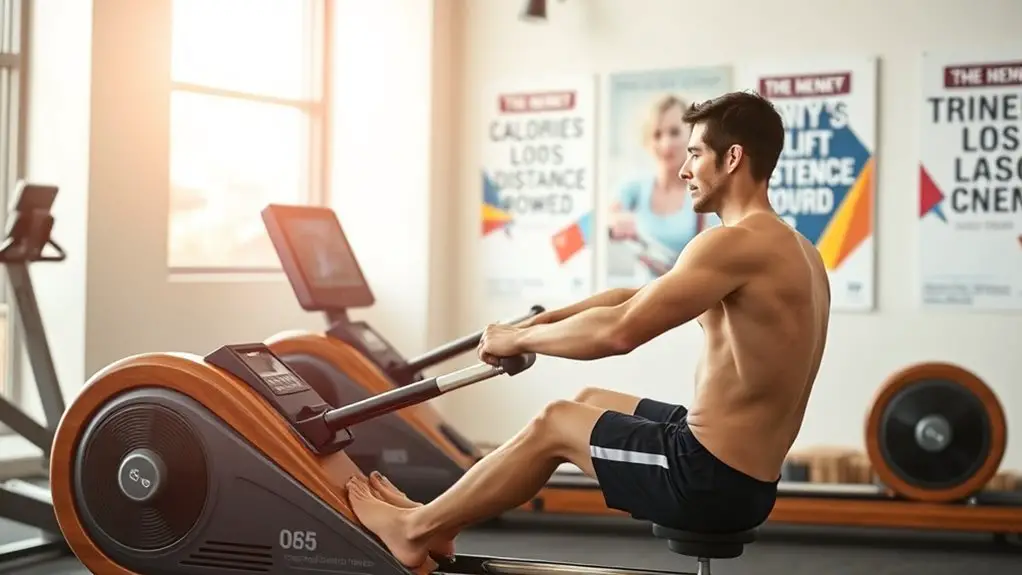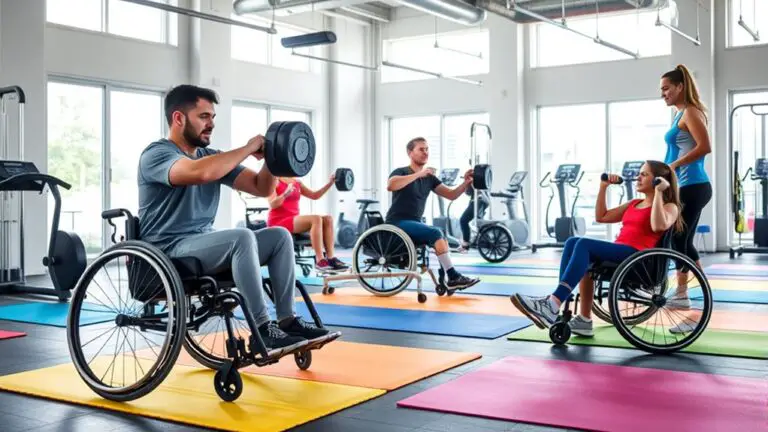Best Rowing Machine Workouts for Weight Loss

Rowing’s one of the best workouts for weight loss, burning up to 600 calories per hour. You’ll engage multiple muscle groups, maximizing your caloric burn efficiently. For effective workouts, try high-intensity interval training (HIIT) or steady-state rowing to enhance endurance. Combine rowing with strength training for added benefits. Don’t forget to track your progress to keep your motivation high. There’s so much more you can learn to make your rowing sessions even more effective.
Understanding the Benefits of Rowing for Weight Loss

While you might think of rowing as just another cardio workout, it actually offers a unique combination of benefits that can greatly aid in weight loss. Rowing engages multiple muscle groups, including your legs, core, and upper body, leading to substantial muscle engagement. This full-body workout maximizes caloric burn, making it more efficient than many other cardio exercises.
As you row, your heart rate increases, helping to improve cardiovascular health while efficiently burning calories. Plus, the low-impact nature of rowing makes it a safer option for those concerned about joint strain. You can easily adjust the resistance to guarantee you’re working at a comfortable level, reducing the risk of injury.
Setting Up Your Rowing Machine for Optimal Use
To get the most out of your rowing machine workouts, it’s essential to set it up correctly. Proper machine adjustments can enhance your performance and prevent injuries. Here are three key areas to focus on:
- Seat Height: Adjust the seat so you can comfortably reach the foot straps without overextending your legs. This guarantees a proper range of motion.
- Foot Straps: Secure your feet in the straps snugly, allowing for a firm grip without cutting off circulation. This aids in maintaining stability throughout your workout.
- Resistance Settings: Start with a moderate resistance level to get a feel for the machine. Gradually increase it as you build strength and endurance, ensuring you maintain control.
Taking the time to make these adjustments will not only keep you safe but also maximize your rowing efficiency. Enjoy your workouts and stay committed to your weight loss goals!
Basic Rowing Technique: Form and Posture

Mastering the basics of rowing technique is essential for both effectiveness and injury prevention. To start, make sure you have a proper grip on the handle; your hands should be relaxed, with fingers holding lightly to avoid strain. Next, focus on your body alignment. Keep your back straight and core engaged throughout the stroke. Your shoulders should be down and relaxed, allowing your elbows to hang naturally.
As you push off with your legs, maintain that alignment. Lean back slightly at the hips, but don’t overextend your back. The power should come from your legs, transferring through your core and into your arms.
High-Intensity Interval Training (HIIT) on the Rowing Machine
High-Intensity Interval Training (HIIT) on the rowing machine can supercharge your weight loss efforts by alternating between short bursts of intense effort and periods of active recovery. This workout structure not only maximizes calorie burn but also greatly boosts your metabolism. Here are three HIIT benefits to take into account:
- Efficiency: Short, intense workouts can deliver results in less time, making it easier to fit exercise into your busy schedule.
- Fat Loss: HIIT is proven to target stubborn fat, helping you achieve a leaner physique.
- Improved Endurance: Regular HIIT sessions enhance your cardiovascular fitness and overall stamina.
To promote safety, always warm up before you start and listen to your body throughout the workout. Gradually increase intensity as you become more comfortable. With consistent effort, you’ll see the results you desire while enjoying the dynamic nature of HIIT on the rowing machine!
Steady-State Rowing Workouts for Endurance

While HIIT workouts are great for boosting your metabolism and burning calories, steady-state rowing offers a different approach that focuses on building endurance. This method involves maintaining a consistent pace over a longer duration, allowing your body to adapt gradually. One of the key steady state benefits is its ability to improve cardiovascular fitness without putting excessive strain on your joints.
You can start with a comfortable pace, aiming for 20 to 40 minutes, and gradually increase the duration as your fitness improves. It’s essential to maintain proper form to prevent injury—keep your back straight and engage your core.
Incorporating steady-state rowing into your routine not only enhances your endurance training but also helps you develop mental resilience. It’s a safe and effective way to manage your weight while enjoying the benefits of low-impact exercise. So, hop on that rowing machine and row at a steady pace!
Combining Rowing With Strength Training
If you’re looking to maximize your workouts, combining rowing with strength training can be a game-changer. This powerful combo not only boosts your calorie burn but also enhances overall muscle tone. Here are three effective ways to integrate both:
- Strength Circuits: Alternate between rowing intervals and bodyweight exercises, like push-ups or squats, to keep your heart rate up while building strength.
- Rowing Intervals: Use high-intensity rowing intervals followed by strength moves, such as kettlebell swings or lunges, to target different muscle groups efficiently.
- Full-Body Workouts: Incorporate rowing as a warm-up, then progress into strength training focusing on compound movements to maximize muscle engagement.
Always prioritize proper form to prevent injuries and guarantee you’re getting the most from your efforts. Balancing rowing with strength training not only accelerates weight loss but also promotes a healthier, stronger body.
Rowing Workouts for Beginners: Getting Started
Starting a rowing routine can feel challenging, but it doesn’t have to be. With the right approach, you can enjoy the process and stay safe. First, get familiar with your rowing machine; check the settings and make sure it’s adjusted to your height. For your beginner tips, start with shorter sessions—10 to 15 minutes—at a comfortable intensity. Focus on your form; keep your back straight and engage your core.
To build consistency, create a simple rowing schedule. Aim for two to three sessions per week, gradually increasing the duration as you get more comfortable. Incorporating rest days is vital for recovery, so listen to your body. Don’t forget to warm up before each session and cool down afterward to prevent injuries. With patience and practice, you’ll find yourself enjoying the benefits of rowing in no time!
Advanced Rowing Workouts for Experienced Users
As you advance in your rowing journey, it is vital to challenge yourself with workouts that push your limits and enhance your performance. Incorporating advanced rowing techniques and competitive rowing strategies can markedly improve your results. Here are three workouts to take into account:
- Interval Training: Alternate between high-intensity bursts and moderate rowing to build endurance and power.
- Pyramid Workout: Gradually increase and then decrease your stroke rate over set intervals, focusing on maintaining form and strength throughout.
- Endurance Rows: Row at a steady pace for longer durations, helping you develop stamina while focusing on your technique.
Always prioritize safety by maintaining proper posture and gradually increasing your intensity. Listen to your body and verify you’re using the right form to prevent injuries. Challenge yourself while staying mindful of your limits, and you’ll see the benefits in no time!
Tracking Your Progress and Staying Motivated
While it’s easy to get caught up in the intensity of your workouts, tracking your progress and staying motivated is essential for long-term success in your rowing journey. Start by setting clear, achievable goals that align with your weight loss objectives. Use a fitness app or a simple journal to log your workouts, noting distances, times, and any personal bests. This goal tracking helps you visualize your progress and keeps you accountable.
To stay motivated, consider joining a rowing community or finding a workout buddy. Sharing your experiences can boost your spirits and provide encouragement. Remember to celebrate small victories along the way; each step counts. Incorporate motivation tips like rewarding yourself after reaching milestones, whether that’s a relaxing day off or a special treat. By focusing on your progress and staying connected, you’ll make your rowing journey enjoyable and sustainable.
Frequently Asked Questions
How Often Should I Row Each Week for Weight Loss?
When it comes to row frequency, aiming for three to five times a week can be effective. It’s essential to balance your workout intensity; mixing moderate and high-intensity sessions helps prevent injury and keeps your motivation up. Start with shorter sessions and gradually increase duration as your fitness improves. Always listen to your body, and give yourself rest days to recover. Consistency is key, so find a routine that fits your lifestyle safely.
Can Rowing Help With Muscle Toning as Well?
Yes, rowing can definitely help with muscle toning. By employing proper rowing techniques, you engage multiple muscle groups, enhancing muscle endurance and strength. As you row, your legs, core, and arms work together, promoting balanced toning throughout your body. To guarantee safety, focus on your form and start at a comfortable pace, gradually increasing intensity. Incorporating rowing into your routine not only tones muscles but also improves overall fitness and endurance.
What Should I Eat Before Rowing Workouts?
Before your rowing workouts, it’s essential to fuel your body with the right pre-workout snacks. Aim for a mix of carbs and protein, like a banana with peanut butter or Greek yogurt with berries. These will give you sustained energy. Don’t forget hydration tips, either—drink water before you start to keep your body well-hydrated. Staying safe and energized will help you get the most out of your rowing session!
How Long Should My Rowing Sessions Last?
When considering your session duration for rowing, it’s important to balance your workout intensity with safety. For most people, a rowing session lasting 20 to 30 minutes is ideal, especially if you’re just starting out. This timeframe allows you to maintain proper form and avoid fatigue. As your fitness level improves, you can gradually increase the duration to 40 or 60 minutes, while ensuring you’re still keeping your intensity at a manageable level.
Are There Any Common Mistakes to Avoid While Rowing?
Did you know that improper rowing technique can lead to injuries for about 30% of new rowers? To stay safe and effective, avoid common errors like slouching your back or overextending your arms. Focus on maintaining a strong core and engaging your legs during each stroke. Remember, proper row technique not only enhances your workout but also protects you from potential harm. So, keep those basics in check to enjoy your rowing journey!





